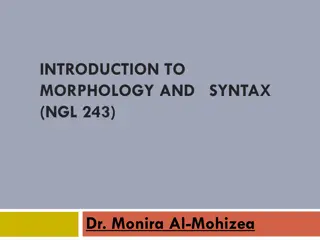Understanding Cycas: A Detailed Look at the Morphology and Characteristics
Sixteen species of Cycas are distributed across tropical and sub-tropical regions, with India hosting six species. Cycas plants are evergreen and resemble palm trees, with unique root and stem structures. The plant body consists of an arborescent stem and distinctive leaf morphology. Cycas leaves are dimorphic, with assimilatory foliage leaves and scaly cataphylls. Explore the fascinating world of Cycas, including its classification and growth habits.
Download Presentation

Please find below an Image/Link to download the presentation.
The content on the website is provided AS IS for your information and personal use only. It may not be sold, licensed, or shared on other websites without obtaining consent from the author. Download presentation by click this link. If you encounter any issues during the download, it is possible that the publisher has removed the file from their server.
E N D
Presentation Transcript
Occurrence: Sixteen species of Cycas are found in the tropical and subtropical parts of the earth. The name Cycas has been derived from a Greek word Kykas = Cocopalm. It is an evergreen plant. In India Cycas is represented by six species C. revoluta, C. pectinata, C. siamensis, C. beddomei, C. rumphiand C. circinalis. Cycas revoluta is the most commonly cultivated species of Indian gardens. It also occurs in China, Africa, Nepal, Sri Lanka and Japan. Its natural habitat is in open, sunny, well-drained situations. It is a palm-like tree with size varies from 1-2 meters. As it yields sago , from the mucilage in its main trunk. It is popularly called sago palm . Leaflets are 6-8 mm broad with revolute margins.
CLASSIFICATION KINDOM- Plantea DIVISION- Cycadophta CLASS- Cycadopsida ORDER- Cycadales FAMILY- Cycadaceae GENUS- Cycas
THE PLANT BODY The Cycas plants are evergreen, slow-growing small trees resemble angiospermous palms in external appearance. The average height of the plant is 3-5m but some some species attain 13-20m also. They are xerophytes and are long lived plant. Each plant consists of a thick unbranched columnar stem which bears a crown of large pinnately compound leaves. Such habit is called ARBORESCENT.
Morphology of ROOT of Cycas Roots are of two types, i.e., normal tap root and coralloid root. Tap root is positively geotropism, non- green, without root hair. It helps in anchorage and absorbs water and minerals. Coralloid roots are lateral branches of tap root. It grows first horizontally (diageotropic) then, repeatedly divide dichotomously, come out of the soil surface in the form of coral like mass.
Morphology of stem of cycas The stem is erect, columnar, woody and un-branched. It is covered with alternate whorls of leaf bases of foliage leaves and scale leaves. The stem apex bears a crown of leaves and sex organs at maturity.
Morphology of leaves of cycas Leaves are dimorphic i.e. 2 types, assimilatory or foliage leaves and scaly leaves or cataphylls. Both the leaf types are born at the stem apex in alternate spirals. Foliage leaves are large (1 -3 m), green, pinnately compound. Petiole has 2 rows of spines. Rachis bears 80-100 pairs of pinnae or leaflets. Leaflets are sessile, elongated, tough, and lanceolate in shape with a spiny apex, revolute or smooth margins. Young leaves have circinate vernation like those of ferns and always covered with brown hairs called ramenta (Fig. 9.3). Scale leaves are small, dry, brown, triangular leaves covered with ramenta. They are non- photosynthetic and protect the stem apex
Anatomy-Root Young root shows typical structure like that of dicotyledonous root. Outermost layer, epiblema, enclosesthe parenchymatous cortex interspersedwith tannin cells and mucilage canal. Endodermis with casparian thickenings Pericycle is multilayred with thin cells having strach grains. Vascular tissue within is typically radial. Roots usually diarch to tetraarch. Vessels absent in vascular tissue. Pith reduced or absent.
Anatomy-Root Older roots shows secondary growth. Cambial ring is initiated between xylem and phloem and completed by differentiation in inner layer of pericycle adjacent to protoxylem elements. These cambial cells are meristematic and add secondary xylem on the inside and secondary phloem towards cortex. Lenticels are developed in old roots.






















